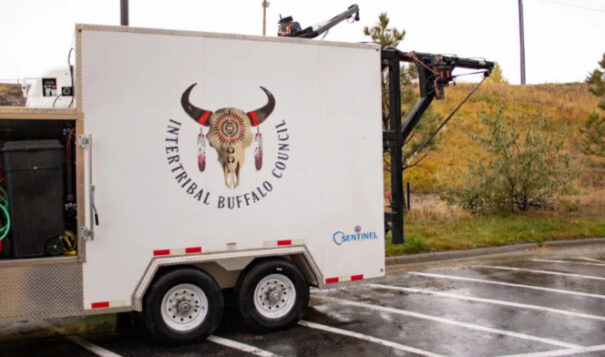News Based on facts, either observed and verified directly by the reporter, or reported and verified from knowledgeable sources.
USDA working with ranchers toward Indigenous food sovereignty
 The InterTribal Buffalo Council field-processing unit allows for tribes to traditionally field harvesting bison while also meeting food regulation safety standards. (Amelia Schafer, ICT and Rapid City Journal).
The InterTribal Buffalo Council field-processing unit allows for tribes to traditionally field harvesting bison while also meeting food regulation safety standards. (Amelia Schafer, ICT and Rapid City Journal).
A new pilot program announced this week aims to localize meat distribution, support small businesses and improve food distribution on reservations
Since the near extinction of the buffalo mostly by White settlers, the animal has become a symbol of both Indigenous resilience and food sovereignty. Now, buffalo are central to a new pilot program to improve food distribution on Native land.
Millions of buffalo were killed for the expansion of the transcontinental U.S. railroad and to reduce a key food source of plains tribes. On Thursday, the U.S. Department of Agriculture announced it is beginning to reconcile the government’s role in the near extinction by supporting buffalo ranchers, specifically Indigenous-operated small businesses.
“The conservation efforts by the tribes and others to restore the bison population since then have been very successful,” said Heather Dawn Thompson, USDA director of the Office of Tribal Relations and a citizen of the Cheyenne River Sioux Tribe. “The federal government has a role in ensuring that perhaps wrongheaded policy in the past is reversed. And so USDA is happy to be a part of the federal partnership and support the restoration of bison.”
The terms bison and buffalo are often interchangeable in and out of Indian Country.
On Oct. 12, the Agriculture Department announced the program with three Indigenous-operated buffalo farms and one non-Native company on the Cheyenne River, Rosebud, Lower Brule and Standing Rock reservations to improve food distribution on reservations, support small businesses and localize meat distribution.

“We’re just trying to feed people,” Troy Heinert, Sicangu Lakota and the Executive Director of the InterTribal Buffalo Council said. “This pilot project is going to be very beneficial so meat can stay local, and people are more connected with where their meat comes from. This administration has done an outstanding job of recognizing that making the rules so that tribes can feed their own people.”
Oceti Sakowin (Lakota, Dakota, Nakota) people have been crucial to the revitalization of the buffalo. Thompson stated all of the herds in the state descend from survivors of the near-extinction protected and raised by the Dupree family on Cheyenne River.
For decades, tribal communities have expressed an interest in localizing food products distributed through the Food Distribution Programs on Indian Reservations (FDPIR), commonly called commodities or “commods.” Over 7,000 reservation families in South Dakota use the FDPIR program.
The pilot program was launched in response to feedback from across Indian Country and from small producers about animal handling, traditional field harvesting, a nature-based purchasing calendar, and inspection.
Representatives from the different parties gathered in Eagle Butte including Thompson, USDA Under Secretary Jennifer Moffitt, and Food Safety and Inspection Service Administrator Paul Keicker. Representatives discussed the progress made in the pilot, listened to feedback and noted potential future improvements.

A pilot member, Ron Brownotter, a Hunkpapa Lakota buffalo rancher, harvests his buffalo the way he was taught by his elders, praying over them and harvesting in the field and not in a plant. As part of the new pilot program, Brownotter can ensure his people are served buffalo harvested in a culturally-conscious manner.
“The buffalo is our culture, it’s who we are, it fits like a glove,” Brownotter said. “Our people evolved with the buffalo, so when it was taken away, a part of us was too.”
The system in place was not set up with tribal businesses in mind, who can’t sell products in bulk. Tradition dictates that buffalo is only to be harvested once a year and field-killed.
“I will never load a buffalo up in a trailer for my people to eat, or any other people to eat and hall to a slaughterhouse because that’s a wild animal,” Brownotter said. “It’s stressed out already in closed confinement, they’re bruising each other and hurting each other with their horns.”
USDA representatives were also available to assist partners in the pilot in the application process, a daunting and time-consuming aspect.
“The process is burdensome and difficult to navigate, particularly if you are a small producer and don’t have a significant staff that’s assigned to just navigating the federal procurement process,” Thompson said.

The program will also provide job opportunities, boosting reservation economies. The Rock Creek community where the Brownotter Buffalo Ranch operates is in a secluded area of Standing Rock where job opportunities are few and far between.
“We’re obviously in a depressed economy on the reservation, jobs are not always plentiful,” Brownotter said. “So me being able to participate in this program allows for income that can hire more workers to do more things on the ranch like fixing fences or working buffalo.”
The goal of the pilot program is to serve as an initiative stepping point in creating more future programs to provide FDPIR recipients with localized, culturally relevant food.
“We hope that this is the first step in purchasing in smaller quantities for all USDA programs,” Thompson said. “We’re starting here, we’re learning lessons together about how to make it run more smoothly. And then we hope to grow it from this pilot.”
Dateline:
EAGLE BUTTE, S.D.
